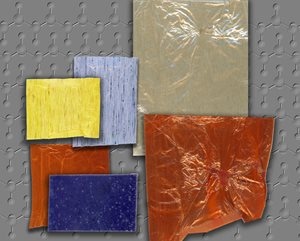Apr 3 2019
Scientists have created new plastic films that remain cool when exposed to sunlight and are very lightweight, bendable, and robust. The versatile materials come in a range of colors and could be integrated into wearable and architectural products to control the temperature of buildings and people without needing any power.
 Researchers developed plastic polyethylene films, available in a rainbow of colors, which can trap or deflect heat and are very lightweight, strong and bendable. (Image credit: Felice Frankel, MIT)
Researchers developed plastic polyethylene films, available in a rainbow of colors, which can trap or deflect heat and are very lightweight, strong and bendable. (Image credit: Felice Frankel, MIT)
“Materials used for wearable technologies and architecture applications require simultaneous control of multiple properties to combine visual appeal with thermal comfort,” said Svetlana Boriskina, Massachusetts Institute of Technology, USA, and leader of the study team that created the materials. “We accomplished this challenging balance by creating the first plastic-based flexible material that combines various optical properties with passive thermal regulation via both conduction and radiation.”
In The Optical Society (OSA) journal Optical Materials Express, the scientists describe how they produced the new films by manipulating the properties of the typically used and low-cost plastic polyethylene and then incorporated color using pigments and nanoparticles. The resulting composite films are strong yet flexible and deliver a range of combinations of thermal, optical, and mechanical properties.
Besides remaining cool when exposed to light, the new materials can also be made to capture heat, which could be used to manufacture warm clothes or to develop camouflage that hides a person or vehicle from night vision cameras by covering the heat they generate.
The materials and processes we used to make these composite films are already commercially available and could likely be used for inexpensive high-throughput fabrication of the films on large scales. The films have a host of potential applications, including being used as substrates and overcoats for thin-film solar cells and other flexible electronic devices as well as for a variety of wearable devices and garments.
Svetlana Boriskina, Study Team Lead, Massachusetts Institute of Technology.
Stretching plastic films
Usually, the color and temperature control characteristics of materials are enhanced separately for various applications. To alter these characteristics concurrently, the scientists started with films composed of ultra-high molecular weight polyethylene. By physically widening the films to different degrees, the scientists learned they could alter the material’s mechanical, optical, and thermal properties.
Stretching the film forces the polymer chains in the plastic to align in one direction parallel to each other, which is very different than what is seen in typical plastics. We demonstrated that this stretching gives the plastic new and useful properties, including ultra-high thermal conductivity, increased broadband transparency, reduced haze, raised melting temperature and high tensile strength.
Svetlana Boriskina, Study Team Lead, Massachusetts Institute of Technology.
To incorporate color and extra optical properties to the films, the scientists implanted different nanoparticles into the polymer prior to stretching the material. Using this process, it is possible to engineer a composite that does not become hot under sunlight by using nanoparticles that trap visible light but do not trap the infrared solar heat. Using particles that efficiently distribute mid-infrared light, on the other hand, will make a material that absorbs heat.
Films with enhanced haze factors could be used as transparent overcoats on thin-film solar cells to boost light absorption while instantaneously helping to lower the solar cell temperature and improve efficiency.
Testing the samples
The scientists developed a range of sample films and tested them with artificial sunlight from a solar simulator in the laboratory. Films having dark silicon nanoparticles, for instance, displayed temperatures 20 °C cooler than a black reference paper colored with black dyes and pigments. The team using infrared camera imaging also noticed that heat dispersed laterally along a sample illuminated by a laser beam. This type of heat dispersal helps lower the temperature of the illuminated hot spot and encourages cooling because the heat travels to areas of the material surface not directly lit by light.
The scientists plan to test their new materials in the real world with natural sunlight before progressing with commercialization plans. They are also using their findings from this study to create polyethylene fibers and knitted or woven textiles that would be beneficial for wearable technologies.
This study involved partners from the Combat Capabilities Development Command Soldier Center and was sponsored by the U.S. Army.